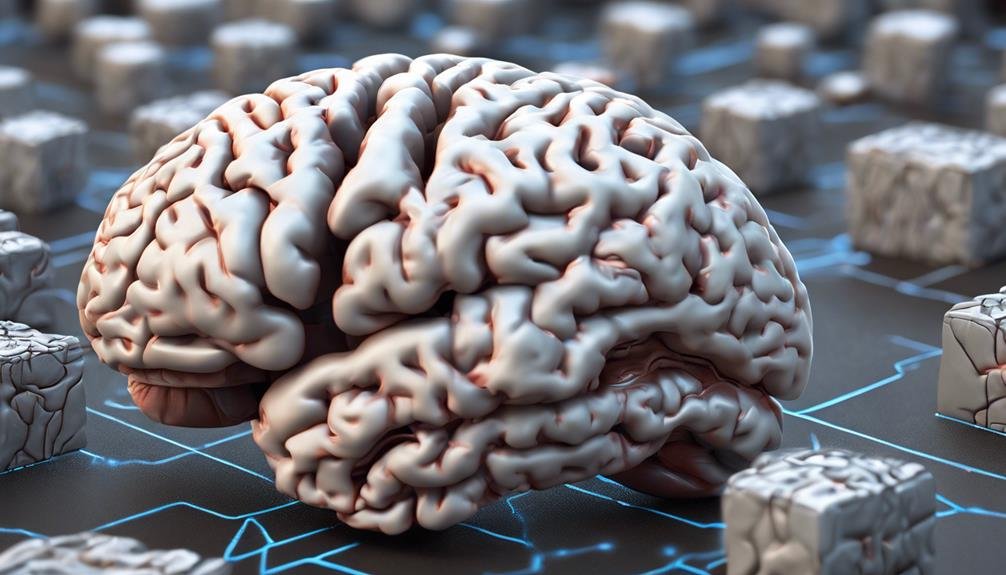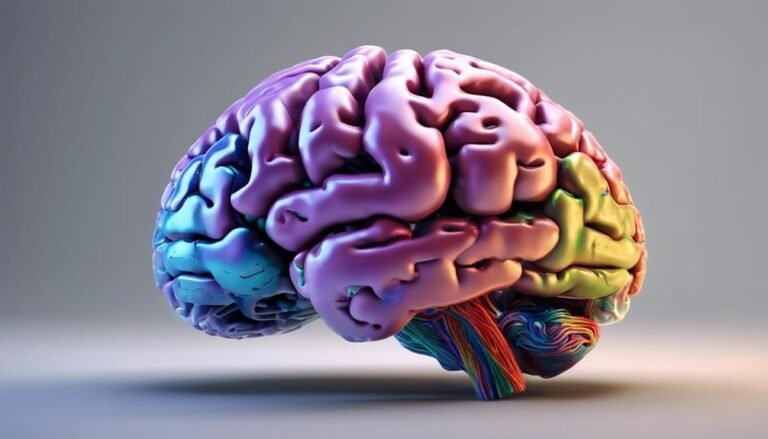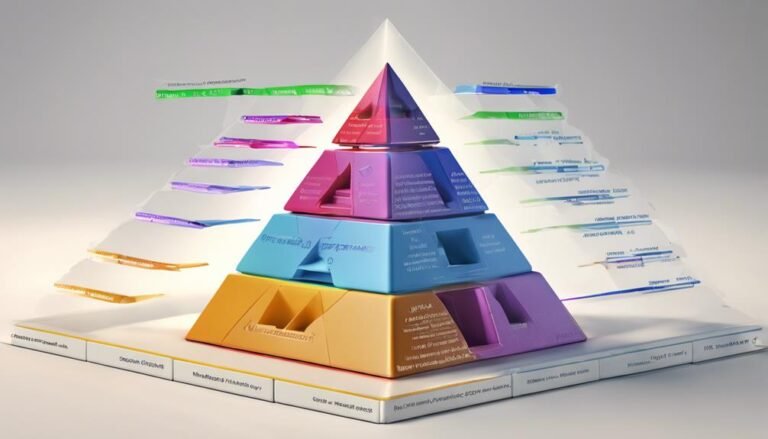Brain Structures and Personality Traits
Did you know that research suggests the amygdala can influence personality traits more than we realize? Understanding how this brain structure interacts with various personality characteristics can shed light on why individuals behave the way they do. As you explore the intricate connections between the amygdala and personality traits, you might uncover fascinating insights into the complexities of human behavior and emotions.
Key Takeaways
- Amygdala influences personality traits through emotional processing.
- Hippocampus impacts personality by encoding memories and regulating emotions.
- Prefrontal cortex shapes personality through decision-making and impulse control.
- Thalamus affects personality by filtering and prioritizing sensory information.
- Cerebellum refines personality traits through motor coordination and skill development.
The Amygdala and Emotional Responses
The amygdala, an indispensable brain structure, plays an essential role in mediating emotional responses by processing and interpreting stimuli related to fear, pleasure, and other emotions. When it comes to fear conditioning, the amygdala is a key player. It's responsible for learning and storing associations between environmental cues and aversive events, leading to fear responses.
In stress responses, the amygdala triggers the activation of the hypothalamic-pituitary-adrenal (HPA) axis, leading to the release of stress hormones like cortisol, which prepares the body for the fight or flight response.
Moreover, the amygdala is critical for emotional regulation. It helps in modulating the intensity of emotional responses and plays a role in inhibiting or promoting behaviors associated with different emotions.
In situations requiring quick reactions, the amygdala is involved in the fight or flight response, where it rapidly processes threatening stimuli and initiates an appropriate response to ensure survival. Understanding the intricate functions of the amygdala provides insights into how emotional experiences shape behavior and influence personality traits.
The Hippocampus and Memory Functions
The hippocampus plays a vital role in memory encoding, aiding in the consolidation of information from short-term to long-term memory.
Research suggests that the size of the hippocampus is correlated with individuals' ability to recall past events and information accurately.
Damage to the hippocampus, whether through injury or neurological conditions, can have significant impacts on a person's memory functions, leading to difficulties in forming new memories or retrieving existing ones.
Hippocampus and Memory Encoding
Located within the brain, the hippocampus plays a pivotal role in encoding and processing memories. Memory consolidation, a process where short-term memories are transformed into long-term memories, heavily relies on the hippocampus. During sleep, particularly during the deep stages of sleep, the hippocampus is actively involved in transferring memories from the short-term storage of the hippocampus to the long-term storage of the neocortex.
Moreover, the hippocampus is intricately linked to the body's stress response. In times of stress, the hippocampus regulates the release of stress hormones such as cortisol, which can impact memory functions. Chronic stress can lead to structural changes in the hippocampus, affecting its function and impairing memory encoding processes. Individuals experiencing prolonged stress may notice difficulties in forming and retrieving memories effectively due to the impact on hippocampal function.
Understanding the role of the hippocampus in memory encoding sheds light on how sleep patterns and stress levels can influence memory formation and retrieval processes.
Hippocampus Size and Recall
Influencing memory functions, the size of the hippocampus has been a subject of scientific interest in understanding memory encoding processes. The hippocampus, a key structure in the brain, plays an essential role in memory retention and cognitive functioning. Research has shown that individuals with larger hippocampal volumes tend to perform better in tasks requiring recall and memory retention. This suggests a strong correlation between hippocampus size and the efficiency of memory processes.
The hippocampus is involved in the formation of new memories and helps in the consolidation of information from short-term to long-term memory. Studies have indicated that a larger hippocampus is associated with enhanced memory recall abilities and overall cognitive functioning. The intricate network of neurons within the hippocampus allows for the encoding and retrieval of memories, essential for various cognitive tasks.
Understanding the relationship between hippocampus size and recall is important in comprehending memory processes and cognitive abilities. Further research in this area may provide valuable insights into memory-related disorders and cognitive decline associated with hippocampal atrophy.
Hippocampus Damage Impacts
Hippocampus damage can greatly impact memory functions, altering the ability to encode and retrieve information efficiently. The hippocampus plays an essential role in memory formation and retrieval processes, and damage to this area can lead to significant memory deficits. Individuals with hippocampal damage may experience difficulty in forming new memories or recalling past events accurately.
Additionally, emotional regulation can be affected, leading to alterations in mood and personality changes. The hippocampus is also necessary for spatial navigation, and damage to this region can result in problems with spatial memory and orientation. Research shows that patients with hippocampal lesions often struggle with tasks that require spatial awareness and navigation abilities.
Understanding the impact of hippocampus damage on memory functions, emotional regulation, and spatial navigation is important in comprehending the broader implications of brain structures on cognitive processes and personality traits.
The Prefrontal Cortex and Decision Making
The prefrontal cortex plays a pivotal role in decision-making processes by integrating sensory information, emotions, and past experiences to guide your choices and actions. Situated in the frontal lobes of the brain, this region is essential for impulse control, risk assessment, and overall executive functions.
When faced with decisions, the prefrontal cortex helps you weigh the potential outcomes, consider the consequences of your actions, and regulate impulsive behaviors.
Studies have shown that damage or dysfunction in the prefrontal cortex can lead to difficulties in decision-making, resulting in impulsive actions, poor risk assessment, and challenges in controlling emotions. This highlights the importance of this brain region in shaping your behavior and choices.
Furthermore, the prefrontal cortex is involved in long-term planning, goal-setting, and social interactions. It allows you to anticipate future events, strategize effectively, and navigate complex social dynamics.
The Thalamus and Sensory Processing
Responsible for relaying sensory information from various parts of the body to the cerebral cortex, the thalamus plays an important role in sensory processing within the brain. The thalamus acts as a central hub for sensory integration, receiving input from different sensory modalities such as vision, hearing, touch, taste, and smell.
Through its intricate network of connections, the thalamus relays this information to the appropriate areas in the cerebral cortex for further processing. The thalamus is essential for sensory perception, as it helps in filtering and prioritizing sensory stimuli before they reach higher cortical regions.
This process ensures that only relevant information is transmitted, allowing for efficient sensory processing and response generation. Additionally, the thalamus plays a role in modulating the level of attention given to sensory inputs, influencing how we perceive and interact with the world around us.
The Cerebellum and Motor Skills
Your cerebellum plays a pivotal role in motor coordination functions, overseeing the precision and timing of your movements. Additionally, the cerebellum is essential for maintaining balance and posture, ensuring you can navigate the world smoothly and efficiently.
Understanding the intricate workings of the cerebellum sheds light on how your brain orchestrates the intricate dance of motor skills in your everyday activities.
Motor Coordination Functions
Located at the base of the brain, the cerebellum plays an essential role in coordinating and refining motor skills essential for daily movements. Fine motor skills, such as precision grip and hand-eye coordination, are finely tuned by the cerebellum. This structure is pivotal for tasks like writing, drawing, or playing a musical instrument, where intricate movements are required.
Motor planning, another key function of the cerebellum, involves mapping out the sequence of movements needed to accomplish a specific task. Muscle memory, developed through repetitive actions, is also governed by the cerebellum. This allows for movements to become automatic and more efficient over time.
Without the cerebellum's involvement, tasks that require precise coordination and timing would be challenging to execute smoothly. Overall, the cerebellum's intricate neural circuits and connections with other brain regions make it an essential powerhouse for refining motor skills and ensuring fluid movements in our daily activities.
Cerebellum and Balance
The cerebellum's intricate neural circuits play an essential role in maintaining balance and refining motor skills essential for daily movements. Balance control is a complex process that involves the integration of sensory information and coordination of muscle activity, tasks in which the cerebellum excels. Through its connections with the spinal cord and other brain regions, the cerebellum fine-tunes movements and guarantees smooth coordination.
Cerebellum development is critical for achieving proper balance and motor skills throughout life. Studies have shown that damage to the cerebellum can result in difficulties with balance, posture, and motor coordination, highlighting its importance in these functions. Additionally, the cerebellum is closely involved in motor learning, facilitating the acquisition of new skills and the adaptation of movements based on feedback.
In essence, the cerebellum's function goes beyond mere motor control; it's essential for maintaining balance and refining motor skills. Its intricate neural circuits contribute significantly to our ability to move effortlessly and with precision, making it a critical structure for everyday movements.
The Hypothalamus and Hormonal Regulation
Within the intricate network of brain structures responsible for regulating various bodily functions, the hypothalamus plays a pivotal role in the intricate dance of hormonal balance and regulation. The hypothalamus, a small but mighty region located below the thalamus, acts as a control center for the endocrine system by communicating with the pituitary gland to regulate the release of hormones that govern essential bodily functions.
One of the key roles of the hypothalamus is in managing the body's response to stress. When faced with a stressful situation, the hypothalamus triggers the release of stress hormones such as cortisol and adrenaline, preparing the body for a 'fight or flight' response. Chronic stress can lead to hormonal imbalance, impacting various physiological processes and potentially contributing to health issues like high blood pressure, impaired immune function, and mood disorders.
In addition to its role in the stress response, the hypothalamus also plays a significant part in regulating hunger, thirst, body temperature, and sleep-wake cycles. Its intricate connections with other brain regions allow for the precise control of hormonal secretions, highlighting its significance in maintaining overall physiological balance.
The Brainstem and Basic Functions
Playing an important role in regulating essential bodily functions, the brainstem is a pivotal region of the brain that's responsible for overseeing basic physiological processes. It controls critical mechanisms such as heart rate, breathing, and blood pressure. The brainstem plays a key role in maintaining homeostasis through its regulation of autonomic responses, guaranteeing that your body functions properly without conscious effort.
One of the significant functions of the brainstem is its involvement in sleep cycles. It helps regulate the sleep-wake cycle by influencing the shifts between different stages of sleep. This intricate process ensures that you experience restorative sleep and wake up feeling refreshed.
Moreover, the brainstem is responsible for various autonomic responses such as pupil dilation, digestion, and sweating. These automatic reactions occur without your conscious control, showcasing the brainstem's importance in maintaining your body's equilibrium.
The Corpus Callosum and Communication Between Hemispheres
Facilitating neural communication between the brain's hemispheres, the corpus callosum serves as an essential bridge for coordinating cognitive functions. Split brain experiments, where the corpus callosum is severed, have provided vital insights into how each hemisphere processes information independently. These experiments revealed that the left hemisphere typically specializes in language, analytical thinking, and logical reasoning, while the right hemisphere excels in visual-spatial tasks, creativity, and emotional processing.
Hemisphere dominance plays a significant role in shaping personality traits. Individuals with a dominant left hemisphere may exhibit traits such as being more analytical, logical, and detail-oriented, while those with a dominant right hemisphere might display characteristics like creativity, intuition, and emotional sensitivity.
The corpus callosum acts as a communication channel between these specialized regions, allowing for the integration of diverse cognitive processes.
Understanding the interplay between the corpus callosum, hemisphere dominance, and cognitive functions provides valuable insights into how neural communication influences personality traits and behavior.
Conclusion
As you journey through the intricate network of brain structures and their influence on personality traits, envision the amygdala as the fiery heart of emotion, the hippocampus as the keeper of memories, and the prefrontal cortex as the rational thinker.
Each structure plays a unique role in shaping who you are, from impulsive tendencies to decision-making skills.
Explore deeper into the complexities of the brain to unravel the mysteries of your own personality.







